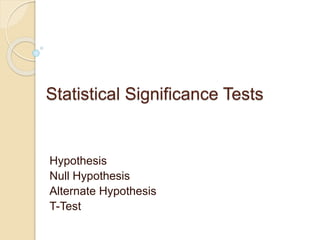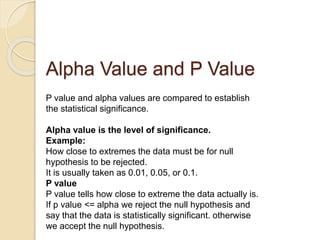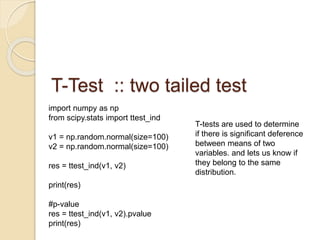Statistical tests help justify if sample results can be applied to a population. ANOVA compares group means and is preferred over t-tests for 3+ groups. It calculates variation between and within groups to obtain an F-ratio. If the F-ratio exceeds its critical value, the null hypothesis that group means are equal is rejected, showing group means differ significantly. Two-way ANOVA extends this to consider two factors' influence, computing interaction effects between factors.
































![SS between
4*3[(8-9)²+(10-9)²] SS (detergent)
2-1=1 DF(detergent)
Mean square(detergent) = 24/1
SS(temperature) 4*2*[(5 − 9)² + (11 − 9)² + (11 − 9)²]
DF(temperature) 3-1=2
Mean square (temp) 192/2
SS(interaction)=4* {(5-8-5+9)^2+(9-8-11+9)^2+(10-8-
11+9)^2+(5-10-5+9)^2+(12-10-11+9)^2+(12-10-11+9)^2
DF(interaction)=(a-1)*(b-1)=2
Mean square(interaction)=16/2
Three F scores are calculated](https://image.slidesharecdn.com/statisticalsignificancetests-230619083029-723d53b1/85/Statistical-Significance-Tests-pptx-33-320.jpg)

![Python code
import pandas as pd
import random
# read original dataset
student_df = pd.read_csv('students.csv')
# filter the students who are graduated
graduated_student_df = student_df[student_df['graduated'] == 1]
# random sample for 500 students
unique_student_id = list(graduated_student_df['stud.id'].unique())
random.seed(30) # set a seed so that everytime we will extract same
samplesample_student_id = random.sample(unique_student_id, 500)
sample_df =
graduated_student_df[graduated_student_df['stud.id'].isin(sample_student_i
d)].reset_index(drop=True)](https://image.slidesharecdn.com/statisticalsignificancetests-230619083029-723d53b1/85/Statistical-Significance-Tests-pptx-35-320.jpg)
![# two variables of interestsample_df = sample_df[['major', 'salary']]
groups = sample_df.groupby('major').count().reset_index()
groups
# calculate ratio of the largest to the smallest sample standard deviation
ratio = sample_df.groupby('major').std().max() /
sample_df.groupby('major').std().min()ratio
Homogeneity of variance Assumption Check
The ratio of the largest to the smallest sample standard deviation is 1.67. T It
should be less than the threshold of 2 which is homogeneity of variance check.](https://image.slidesharecdn.com/statisticalsignificancetests-230619083029-723d53b1/85/Statistical-Significance-Tests-pptx-36-320.jpg)
![# Create ANOVA backbone table
data = [['Between Groups', '', '', '', '', '', ''], ['Within
Groups', '', '', '', '', '', ''], ['Total', '', '', '', '', '', '']]
anova_table = pd.DataFrame(data, columns =
['Source of Variation', 'SS', 'df', 'MS', 'F', 'P-value',
'F crit'])
anova_table.set_index('Source of Variation',
inplace = True)
Source
of
variation
SS DF MS F P-
value
F-Crit](https://image.slidesharecdn.com/statisticalsignificancetests-230619083029-723d53b1/85/Statistical-Significance-Tests-pptx-37-320.jpg)
![# calculate SSTR and update anova table
x_bar = sample_df['salary'].mean()
SSTR = sample_df.groupby('major').count() *
(sample_df.groupby('major').mean() - x_bar)**2
anova_table['SS']['Between Groups'] = SSTR['salary'].sum()
# calculate SSE and update anova table
SSE = (sample_df.groupby('major').count() - 1) *
sample_df.groupby('major').std()**2
anova_table['SS']['Within Groups'] = SSE['salary'].sum()](https://image.slidesharecdn.com/statisticalsignificancetests-230619083029-723d53b1/85/Statistical-Significance-Tests-pptx-38-320.jpg)
![# calculate SSTR and update anova table
SSTR = SSTR['salary'].sum() + SSE['salary'].sum()
anova_table['SS']['Total'] = SSTR
# update degree of freedom
anova_table['df']['Between Groups'] =
sample_df['major'].nunique() – 1
anova_table['df']['Within Groups'] = sample_df.shape[0] -
sample_df['major'].nunique()
anova_table['df']['Total'] = sample_df.shape[0] – 1
# calculate MS
anova_table['MS'] = anova_table['SS'] / anova_table['df']](https://image.slidesharecdn.com/statisticalsignificancetests-230619083029-723d53b1/85/Statistical-Significance-Tests-pptx-39-320.jpg)
![# calculate F F = anova_table['MS']['Between Groups'] /
anova_table['MS']['Within Groups']
anova_table['F']['Between Groups'] = F
# p-value
anova_table['P-value']['Between Groups'] = 1 - stats.f.cdf(F,
anova_table['df']['Between Groups'], anova_table['df']['Within
Groups'])](https://image.slidesharecdn.com/statisticalsignificancetests-230619083029-723d53b1/85/Statistical-Significance-Tests-pptx-40-320.jpg)
![# F critical
alpha = 0.05
# possible types "right-tailed, left-tailed, two-tailed“
tail_hypothesis_type = "two-tailed“
if tail_hypothesis_type == "two-tailed":
alpha /= 2
anova_table['F crit']['Between Groups'] = stats.f.ppf(1-alpha,
anova_table['df']['Between Groups'], anova_table['df']['Within
Groups'])
# Final ANOVA Table
anova_table](https://image.slidesharecdn.com/statisticalsignificancetests-230619083029-723d53b1/85/Statistical-Significance-Tests-pptx-41-320.jpg)
